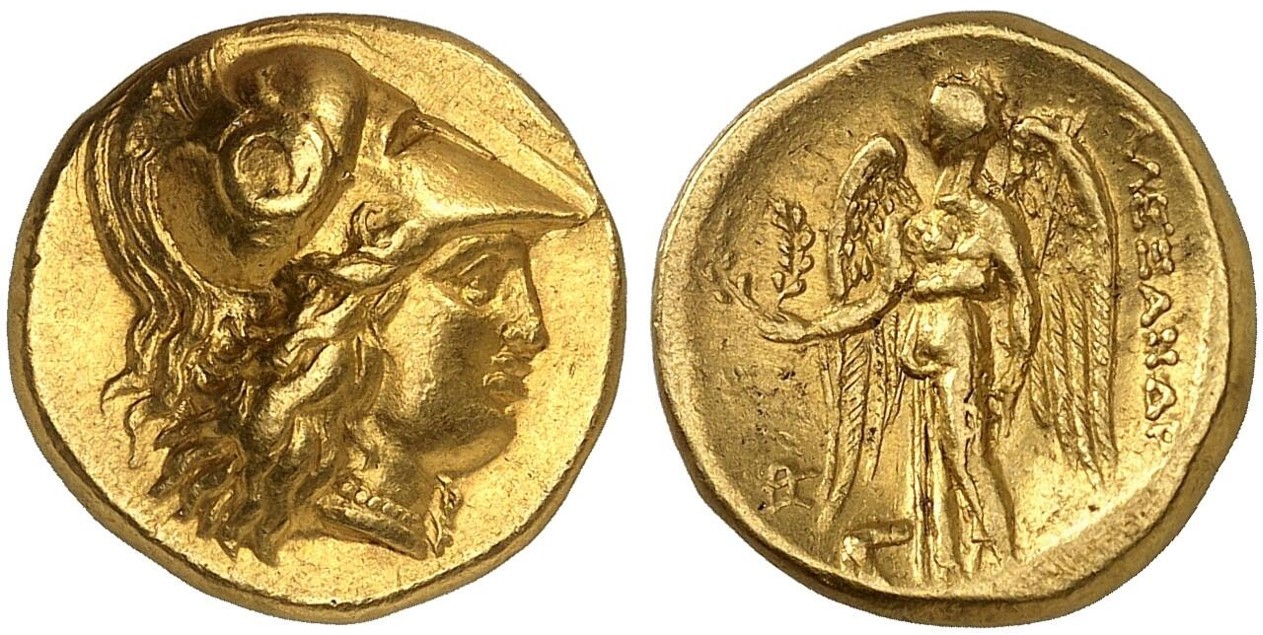Ecbatana (Seleucus I), gold, staters (Athena/Nike) (311-280 BCE)
From SILVER
311 BCE - 280 BCE Gold 47,641 kg
Description
| ObverseInscription or printing placed on the obverse.: | Head of Athena right, wearing a Corinthian helmet. |
| ReverseInscription or printing placed on the reverse.: | ΑΛΕΞΑΝΔΡΟΥ (Greek).Nike to right, holding stylis and crown. In the field, one or two symbol(s) (a forepart of a grazing horse, ancor) and/or one or two monogram(s) and/or letters. |
Mint and issuing power
| MintIdentifies the place of manufacture or issue of a numismatic object.: | Ecbatana | Ancient regionAncient region.: | Media | Modern countryModern country: Iran | AuthorityIdentifies the issuing power. The authority can be "pretended" when the name or the portrait of X is on the coin but he/she was not the issuing power. It can also be "uncertain" when there is no mention of X on the coin but he/she was the issuing power according to the historical sources: | Alexander III the Great (Argead king, 336-323 BC), Seleucid Dynasty (312-63 BC), Seleucus I Nicator (satrap in 321-305 BC and Seleucid king in 305-281 BC) |
Chronology
| FromIdentifies the initial date in a range assigned in a numismatic context. | 311 BCE | toIdentifies the final date in a range assigned in a numismatic context.. | 280 BCE | PeriodTime period of the numismatic object.: Hellenistic 323-30 BC |
Physical description
| MetalThe physical material (usually metal) from which an object is made.: | Gold |
Median weightMedian of the weights of numismatic objects (in grams). in grams | 8.55 | DenominationTerm indicating the value of a numismatic object. Examples: tetradrachm, chalkous, denarius.: | stater |
StandardStandard.: | Attic |
Image

Ecbatana seleucus I stater.jpg [1]
References
| Die study referencePublication of the study: | Boillet 20091Boillet 2009, p. 41-44, no. 6-18. | ||
| Coin series referenceReference to coin series study: | Price 19912Price 1991, n° 3882, 3927 and 3901, SC I3SC I, n° 200-201 | ||
| Coin series web referenceCoin series web references: | |||
Obverse dies distribution
Reverse dies distribution
no distribution is available
Quantification
| Number of obversesNumber of obverse dies. ᵖ (o) | 10 | Number of singletons (o1)The number of singleton coins. ᵖ | 7 |
| Number of reverse diesNumber of reverse dies. (r) | 11 | Number of coinsNumber of coins. (n) | 14 |
| Coins per obverse dieNumber of coins per obverse die. (n/o) | 1.4 | Coins per reverse dieNumber of coins per reverse die. (n/r) | 1.27 |
| Reverse per obverse ratioRatio of obverse dies divided by reverse dies. (r/o) | 1.1 | Percentage of singletons (o1)number of coins (n) divided by the number of singletons (o1) ᵖ | 70 % |
| Original number of dies (O) (Carter 1983 formula)The estimation of the number of coins according to Carter 1983 ᵖ | 27.86 | Coins struck if 20,000 as average productivity per dieCoins made if the average productivity for obverses (according to Carter) is 20,000. ᵖ | 557,200 |
| Original number of dies (O) (Esty 2011 formula)The estimation of the number of coins according to the singleton formula in Esty 2011 ᵖ (O) | 35 | Survival rate if 20,000 as average productivity per dieSurvival rate if average productivity is 20,000. ᵖ | 0.00003 |
| Coverage (o = % of O) (Esty 1984 formula)Esty 1984 - coverage (% of O) ᵖ (o = % of O) | 50% | Die productivity if survival rate 1/2,000Average productivity if survival rate is 1/2,000. ᵖ | 1,005.03 |
| Weight of silver (in kg) if 20,000 coins per die (O = Carter formula)Carter 1983 * Median weight * 20000 (*10 if gold or electrum) ᵖ | 47,641 kg <br /> 47,641 kg | Die productivity if survival rate 1/5,000Average productivity if survival rate is 1/5,000. ᵖ | 2,512.56 |
Remarks
Most likely one single workstation Likely military
References
- ^ Boillet, Pierre-Yves (2009), Ecbatane et la Médie d’Alexandre aux Arsacides (c. 331 a.C. - c. 224 p.C.). Histoire monétaire et économique, unpublished doctoral dissertation, Bordeaux University.
- ^ Price, Martin Jessop (1991), The Coinage in the Name of Alexander the Great and Philip Arrhidaeus: a British Museum Catalogue, 2 vol., Zürich-London, 637 p., 637 p., clix pl.
- ^ Houghton, Arthur - Lorber, Catharine (2002), Seleucid coins : a comprehensive catalogue. Part 1, Seleucus I through Antiochus III, New York - Lancaster - London, 2 v. (xxxviii, 488 p. + 300 p.), 101 pl.